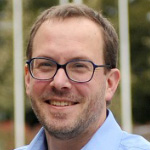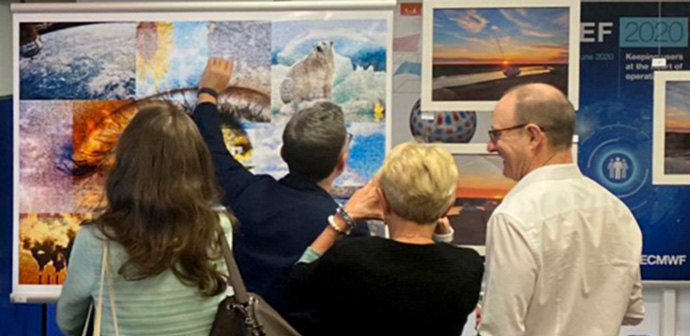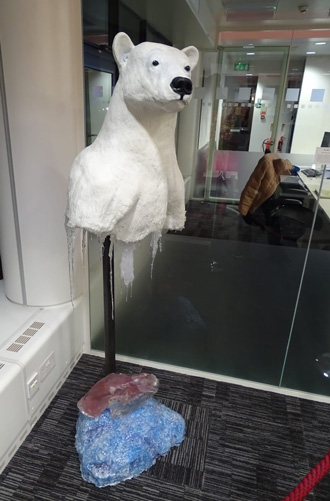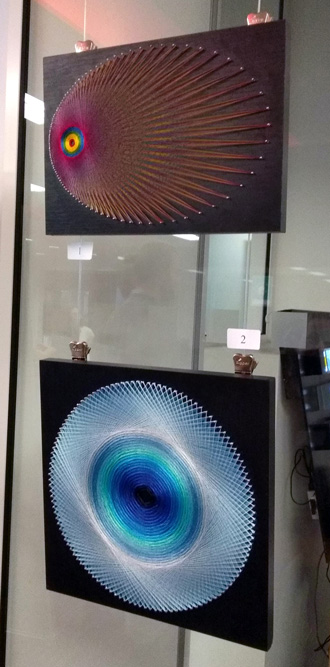 |
 |
 |
 |
Top: Louise Arnal, Postdoc at the University of Saskatchewan and former PhD student at ECMWF and Anna Ghelli, Acting Head of User Services.
Below: Jenny Rourke, Head of Production Services and Florian Pappenberger, Director of Forecasts.
ECMWF is tackling environmental issues of societal relevance, which require scientific knowledge and creativity. Merging science and art can help engage with a wider audience on these scientific topics, foster dialogue between scientists, artists and the audience, and ultimately lead to new out-of-the box ideas to tackle current environmental issues.
It’s a topic close to our hearts and a focus of Louise's recently completed PhD at ECMWF on “The Art of Streamflow Forecasting Over Europe”, which included a SciArt exhibition to open discussions about flood forecasting to a wider audience. Louise comments: "As my time at ECMWF came to an end, I was pleased to be involved in ECMWF’s first science and art exhibition along with co-organisers Anna Ghelli, Jenny Rourke and Florian Pappenberger."
On Tuesday, 18 February 2020, over 80 artworks from 27 artists were displayed for the exhibition opening event in the ECMWF Weather Room.

The artworks ranged from sculptures to paintings and photography, and all conveyed weather-related topics in their own beautifully unique ways.
This exhibition displayed artworks submitted as part of the ECMWF art competition, organised to give ECMWF staff (and their relatives) the opportunity to decorate the ECMWF corridors and inhabit the space they work in. Visitors to the exhibition could vote for their three favourite artworks, and the following pieces received the most votes.
1. “Guarda... (Look...)” by Loriano Pagni

According to the artist, “the title is open to interpretation”. The eye of the child (the new generation) is watching and warning us, asking us to act in the face of climate change. It can also be interpreted as the eye of the scientific community studying and observing. This piece is an invitation for everyone to "look" at what our planet is going through and, finally, a more playful call for staff to look for their image in the mosaic of ECMWF staff photos.
To create this piece, Loriano, an ECMWF IT engineer, used the digital photos of 383 members of staff, as for him “the essence of ECMWF is its staff”. All photos were combined and duplicated to fill an A0 mosaic (the mosaic is made of ~278,000 photos!). Superimposed on top of the mosaic, one can recognise photos related to weather/climate carefully selected by Loriano: satellite observations, a sunflower, a polar bear (with little ice left) being watched by "us" (the ECMWF "symbol": a rubber duck), lightning during a storm, a firestorm/wildfire, a sunny sky, a rainbow and rain, pollution and drought, a sea sunset, Earth reflected in the eye and as seen from the International Space Station.
It took Loriano 14 days to put this piece together using several computer art software packages. Loriano said: “save, save, save more often than you think and on more than one storage device”, echoing with the scientific practice.
2. “Qailertetang: Burning Arctic” by Ricardo Varela

“Qailertetang” is an Inuit deity who cares for animals, fishers, and hunters, and who controls the weather. The sculpture itself is of a melting polar bear which represents the dramatic consequences of human-induced climate change in the Arctic.
ECMWF of course has a key role in creating skilful forecasts amidst changing weather conditions, and in providing reliable guidance to anticipate extreme weather worldwide.
This piece is composed of a sculpture of a melting polar bear bust attached through a rusty square iron tube (to remind us that industry is largely responsible for human-induced climate change) to an ice floe. Icicles drip from the bear onto the iceberg and onto a bear skull made of “artificial ice”.
Ricardo, the husband of an ECMWF scientist and a taxidermist by training, used his skills to realise this piece from a range of techniques and materials (please note that this sculpture is not taxidermy!).
The bear bust was sculpted from polyurethane, to which clay (for the hair-like structure), glass (for the eyes) and finally paint were added. The falling icicles are made of resin. For the skull, also made of resin, a mould was created from an old bear skull. The ice floe was made of iron and polyurethane and painted with different shades to give a feeling of depth in the ice. For the finishing touch, some resin was moulded on the paint to simulate the ice melting.
3. "Meteor" and "Tropical Cyclone" by Milana Vuckovic

The word meteorology is from the Ancient Greek μετέωρος metéōros (meteor) and -λογία -logia (-(o)logy), meaning "the study of things high in the air". These two pieces present an abstract perspective of “things high in the air”, namely a meteor and a tropical cyclone, offering a different viewpoint on environmental topics at the heart of the ECMWF practice.
The technique used by Milana, an ECMWF analyst, to create these pieces is called ‘String Art’, where pins and embroidery thread are used to create designs.
Milana says: “This used to be a family hobby. My father learned how to do String Art in the 70s and taught me when I was little. I loved experimenting with thread, and it was my dad who would prepare wooden boards and pins for me. But he died suddenly two years ago, and now I'm trying to figure out the whole process from memory and his sketches. It is not easy, and some parts of the process take a lot of practice. The art exhibition was an amazing idea and it came at the right time for me. I had never expected such positive feedback, it is truly a great motivation to keep doing this.”
These pieces and all other submitted artworks will be displayed throughout ECMWF to decorate corridors and meeting rooms.
The ECMWF science and art exhibition was very well received. It made space for ECMWF scientists to express their creativity through scientific topics they are passionate about and reflect on their scientific field in a very different way from their daily routines. It gave all artists the chance to engage with ECMWF staff and their families about weather-related topics using a medium accessible to all: art.
Ricardo Varela said: “I am really happy with the idea that ECMWF organised this cultural event, the sum of science and art can be very positive to disseminate scientific concepts for people who are not familiar with them and to create environmental awareness in society.”
You can also see a short video of the art and science exhibition below.
